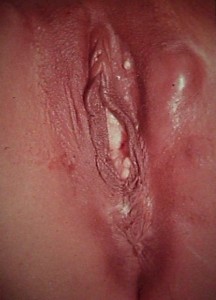Lymphogranuloma venereum is an uncommon sexually-transmitted disease caused by a variant of Chlamydia trachomatis.
Following initial exposure, there is mild, blister-like formation which is frequently unnoticed. Within the following month, there is ulceration of the vaginal, rectal or inguinal areas. At this stage, the disease is very painful, particularly with walking, sitting and with bowel movements. The stool may be blood-streaked.

Hard tender masses (buboes) arise in the inguinal area at this stage and are characteristic of the disease.
As the disease progresses untreated, extensive scarring in the rectal area may require surgery to enable normal bowel movements. Scarring in the vaginal area can lead to painful intercourse or make intercourse basically impossible.

Confirmation of the disease is optimally achieved with a positive Chlamydia trachomatis serotype culture from a bubo. Often, less specific tests, such as serum complement fixation test with acute and convalescent samples are used. In many operational settings, none of these tests are available and the diagnosis is made by history of exposure, visual appearance of the lesions and known prevalence in the population.
Treatment*
At the time of the initial visit (before diagnostic tests for chlamydia are available), persons with a clinical syndrome consistent with LGV, including proctocolitis or genital ulcer disease with lymphadenopathy, should be presumptively treated for LGV. As required by state law, these cases should be reported to the health department.
Treatment cures infection and prevents ongoing tissue damage, although tissue reaction to the infection can result in scarring. Buboes might require aspiration through intact skin or incision and drainage to prevent the formation of inguinal/femoral ulcerations.
Recommended Regimen
- Doxycycline 100 mg orally twice a day for 21 days
Alternative Regimen
- Erythromycin base 500 mg orally four times a day for 21 days
Although clinical data are lacking, azithromycin 1 g orally once weekly for 3 weeks is probably effective based on its chlamydial antimicrobial activity. Fluoroquinolone-based treatments also might be effective, but the optimal duration of treatment has not been evaluated.
Other Management Considerations
Patients should be followed clinically until signs and symptoms have resolved. Persons who receive an LGV diagnosis should be tested for other STDs, especially HIV, gonorrhea, and syphilis. Those who test positive for another infection should be referred for or provided with appropriate care and treatment.
Follow-up
Patients should be followed clinically until signs and symptoms resolve.
Management of Sex Partners
Persons who have had sexual contact with a patient who has LGV within the 60 days before onset of the patient’s symptoms should be examined and tested for urethral, cervical, or rectal chlamydial infection depending on anatomic site of exposure. They should be presumptively treated with a chlamydia regimen (azithromycin 1 g orally single dose or doxycycline 100 mg orally twice a day for 7 days).
Special Considerations
Pregnancy
Pregnant and lactating women should be treated with erythromycin. Doxycycline should be avoided in the second and third trimester of pregnancy because of risk for discoloration of teeth and bones, but is compatible with breastfeeding. Azithromycin might prove useful for treatment of LGV in pregnancy, but no published data are available regarding an effective dose and duration of treatment.
HIV Infection
Persons with both LGV and HIV infection should receive the same regimens as those who are HIV negative. Prolonged therapy might be required, and delay in resolution of symptoms might occur.
*CDC 2015 STD Treatment Guidelines
